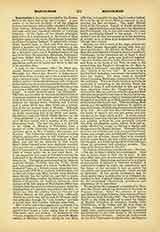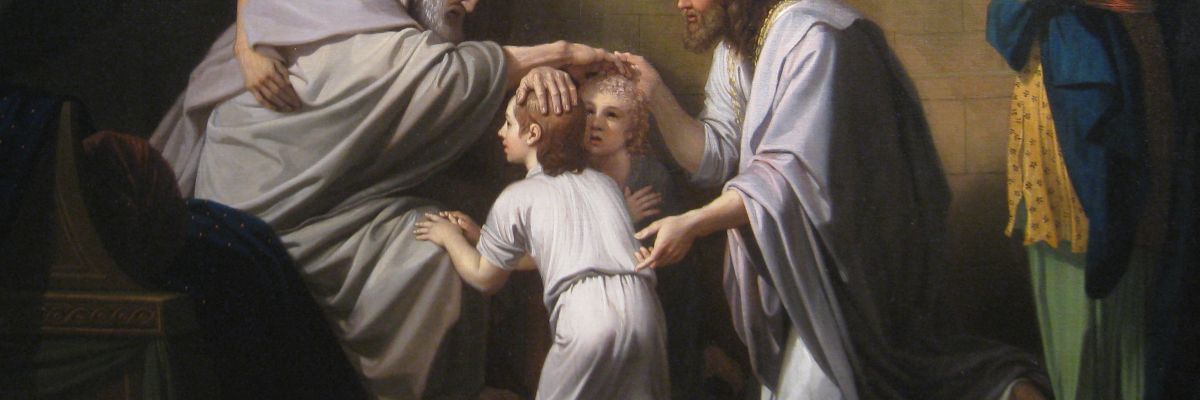

Manasses, the name of seven persons of the Bible, a tribe of Israel, and one of the apocryphal writings.
THE INDIVIDUALS.—(I) MANASSES (Heb. MNSH; Sept. Manass?), eldest son of Joseph and the Egyptian Aseneth (Gen., xli, 50-51; xlvi, 20). The name means “he that causes to forget”; Joseph assigned the reason for its bestowal: “God hath made me to forget all my toils, and my father’s house” (Gen., xli, 51). Jacob blessed Manasses (Gen., xlviii); but gave preference to the younger son Ephraim, despite the father’s protestations in favor of Manasses. By this blessing, Jacob put Manasses and Ephraim in the same class with Ruben and Simeon (verses 3-5), and gave foundation for the admission of the tribes of Manasses and Ephraim.
MANASSES, Judith’s husband, died of sunstroke in Bethulia (Judith, viii, 2-3).
MANASSES, a character in the story of Ahikar (not in Vulg., but in Sept.) told by Tobias on the point of death. The Vatican MS. mentions Manasses (Manass?s) as one “who gave alms and escaped the snare of death”; the Sinaitic MS. mentions no one, but clearly refers the almsgiving and escape to Achiacharus. The reading of the Vatican MS. is probably an error (“Rev. Bibl.”, January, 1899).
MANASSES, son of Bani, one of the companions of Esdras who married foreign wives (I Esd., x, 30).
MANASSES, son of Hasom, another of the same companions of Esdras (I Esd., x, 33).
MANASSESI (according to k’thibh of Massoretic Text and Sept.), ancestor of Jonathan, a priest of the tribe of Dan (Judges, xviii, 30). The Vulgate and k’ri of the Massoretic Text give Moses, the correct reading.
MANASSES, thirteenth King of Juda (692-638 B.C.—cf. Schrader, “Keilinschr. and das A. T.”), son and successor to Ezechias (IV Kings, xx, 21 sq.). The historian of IV Kings tells us much about the evil of his reign (xxi, 2-10), and the punishment thereof foretold by the Prophets (verses 10-15), but practically nothing about the rest of the doings of Manasses. He brought back the abominations of Achaz; imported the adoration of “all the host of heaven”, seemingly the astral, solar, and lunar myths of Assyria; introduced the other enormities mentioned in the Sacred Text; and “made his son pass through fire” (verse 6) in the worship of Moloch. It was probably in this frenzy of his varied forms of idolatry that “Manasses shed also very much innocent blood, till he filled Jerusalem up to the mouth” (verse 16). The historian of II Par. tells much the same story, and adds that, in punishment, the Lord brought the Assyrians upon Juda. They carried Manasses to Babylon. The lord heard his prayer for forgiveness and deliverance, and brought him again to Jerusalem, where Manasses did his part in stemming the tide of idolatry that he had formerly forced upon Juda (xxxiii, 11-20). At one time, doubt was cast on the historicity of this narrative of II Par., because IV Kings omits the captivity of Manasses. Schrader (op. cit., 2nd ed., Giessen, 1883, 355) gives cuneiform records of twenty-two kings that submitted to Asarhaddon during his expedition against Egypt; second on the list is Mi-na-si-i sar ir Ya-u-di (Manasses, king of the city of Juda). Schrader also gives the list of twenty-two kings who are recorded on a cuneiform tablet as tributaries to Asurbanipal in the land of Hatti; second on this list is Mi-insi-i sar mat Ya-u-di (Manasses, king of the land of Juda). Since a Babylonian brick confirms the record of the historian of II Par., his reputation is made a little more secure in rationalistic circles. Winckler and Zimmern admit the presence of Manasses in Babylon (see their revision of Schrader’s “Keilinschr. and das A. T.” I, Berlin, 1902, 274). Conjectures of the Pan-Babylonian School, as to the causes that led to the return of Manasses, the groundwork of the narrative in IV Kings, etc., do not militate against the historical worth of the Inspired Record.
THE TRIBE.—Deriving its name from MANASSES (I), son of Joseph, this tribe was divided into two half-tribes—the eastern and the western. The tribe east of the Jordan was represented by the descendants of Machir (Judges, v, 14). Machir was the first-born of Manasses (Jos., xvii, 1). The children of Machir took Galaad (Num., xxxii, 39); Moses gave the land of Galaad to Machir (verse 40). Two other sons of Manasses, Jair and Nobe, also took villages in Galaad, and gave thereto their own names (verses 41-42). The territory of the western half-tribe is roughly sketched in Jos., xvi, 1-3. It was that part of Samaria which lay between the Jordan and the Mediterranean, the plain of Esdrelon and the towns of Jericho, Sichem, and Samaria. The eastern half-tribe occupied north Galaad, all Basan, and Argob (Jos., xiii, 30-31; cf. Dent., iii, 13)—an immense tract of land extending east of Jordan to the present Mecca route (darb el-haj) and far beyond, so as to include the Hauran.
THE WRITING.—The Prayer of Manasses is an aprocryphal writing which purports to give the prayer referred to in II Par., xxxiii, 13, 18-19. Its original is Greek. Nestle thinks that the prayer and other legends of Manasses in their present form are not earlier than the “Apost. Const.”, xi, 22; and that the prayer found its way into some MSS. of the Septuagint as part, not of the Sept., but of the “Apost. Const.” (see “Septuaginta Studien”, III, 1889). The prayer is not in the canon of Trent, nor has there ever seemed to have been any serious claim to its canonicity.
WALTER DRUM


